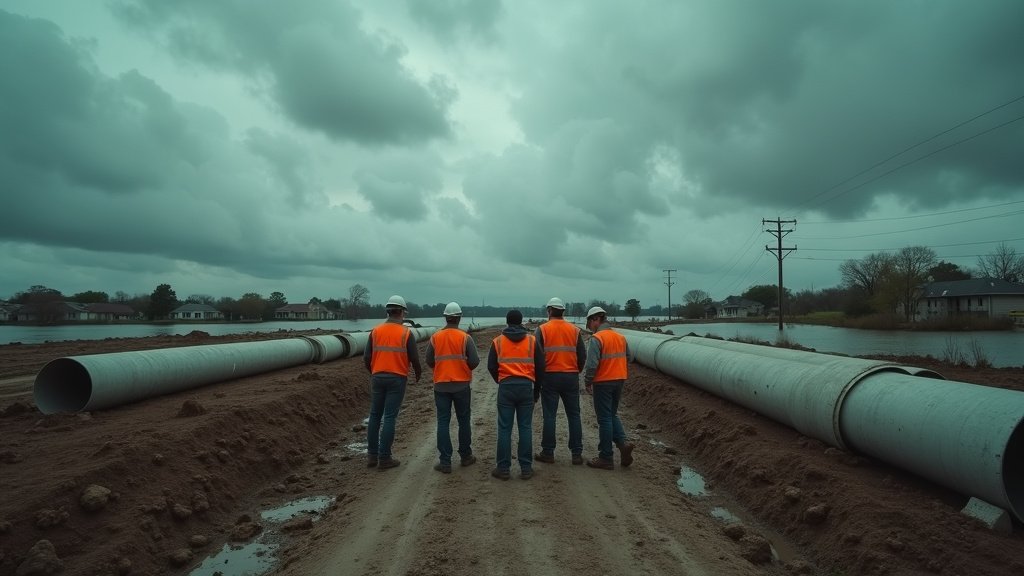Harris County officials have announced that a significant number of flood prevention projects, initially funded by a landmark $2.5 billion bond approved by voters in 2018, are now being closed or placed on hold due to substantial funding shortfalls. This development casts a shadow over the county’s efforts to bolster flood resilience in the wake of devastating storms like Hurricane Harvey.
The $2.5 Billion Promise After Harvey
In August 2018, just one year after Hurricane Harvey unleashed widespread devastation across the region, Harris County voters overwhelmingly approved a $2.5 billion bond package aimed at undertaking hundreds of flood damage reduction projects. The initiative was heralded as the largest local investment in flood control in the county’s history and was intended to fund projects over a 10-year period. The bond was designed to finance a wide array of recovery and resiliency efforts, including home buyouts, bayou widening, early flood warning systems, and the dredging of key dams. The goal was to reduce flood risk and protect communities that had suffered immense losses.
A Deepening Funding Chasm
However, the ambitious plan has been significantly hampered by escalating costs and funding challenges. While the county has secured an additional $2.7 billion in partner funding, bringing the total allocated resources to approximately $5.2 billion, officials now reveal a substantial gap. Various reports indicate a shortfall ranging from $1 billion to $1.4 billion, with some analyses pointing to a $1.07 billion unexplained decrease in remaining funds.
County officials largely attribute this deficit to an estimated 8% inflation rate, coupled with rising construction costs and construction challenges exacerbated by the pandemic. Earlier reports also highlighted that projected funding from state and federal partners, which was expected to supplement the local bond investment, has not materialized as anticipated. Director for the Flood Control District, Tina Petersen, stated that roughly $410 million more would be required to complete the projects that are currently unfunded.
Projects Halted: The Toll on Flood Prevention
The financial strain has led to difficult decisions regarding the project pipeline. According to recent announcements, 15 projects that had not yet broken ground are now being closed. These projects have been determined to be not technically feasible, a factor beyond just funding. Additionally, 26 projects that had already commenced are being put on hold, awaiting future funding.
While 75 projects currently under construction are slated for completion, their finalization is expected to take another three to five years, extending well beyond the bond’s initial 10-year timeline. A total of 54 projects have been officially completed. This situation raises concerns about the timely delivery of promised flood protection measures, particularly for communities that remain highly vulnerable to future flooding events.
Debate Over Equity and Priorities
The allocation and prioritization of flood control funds have become a significant point of contention. Since the bond’s inception, there has been a push to ensure equity in project implementation, particularly for historically underserved communities. Advocates, including environmental equality advocate Stephany Valdez and Commissioner Rodney Ellis, have voiced concerns that the established prioritization framework, which considers factors like social vulnerability, has not been adequately followed.
Valdez has expressed that the process was “offensive” and harmed communities in need, suggesting that the framework, designed to prioritize high-need projects, has been disregarded. Conversely, Commissioner Tom Ramsey has questioned the equity formula, suggesting it may be flawed and has advocated for a more equal distribution of remaining funds across all precincts, expressing concern that Precinct 3, the sole Republican-led district, could bear disproportionate cuts.
To address some of these issues, Harris County commissioners have recently voted to prioritize “quartile one” projects – those deemed most urgent and serving the county’s most vulnerable populations – along with projects involving outside partnerships. This approach aims to secure existing partnerships and federal grants while focusing on critical needs. However, the fate of projects in quartiles 2, 3, and 4 remains uncertain, with officials expected to make further decisions in September.
Questions of Transparency and Future Funding
The significant funding discrepancies have also led to calls for greater transparency. Watchdog groups and some media analyses have raised questions about unexplained drops in remaining bond funds, with critics noting that official updates have not always clarified these variances. The Harris County Flood Control District is working to develop a public dashboard to track project status updates, aiming to improve accountability.
County Judge Lina Hidalgo has acknowledged the difficult choices ahead, stating, “We are not going to be able to do all the projects that people were promised and that failure was built into the bond, and that’s disappointing”. Looking forward, county leaders are grappling with how to manage the remaining funds and are considering the possibility of seeking additional voter-approved funding in the future to complete the intended flood mitigation efforts. The decisions made in the coming months will shape the future of flood protection for millions of Texas residents. This ongoing situation remains a trending topic in Texas news, underscoring the persistent challenges in securing adequate funding for critical infrastructure projects.






